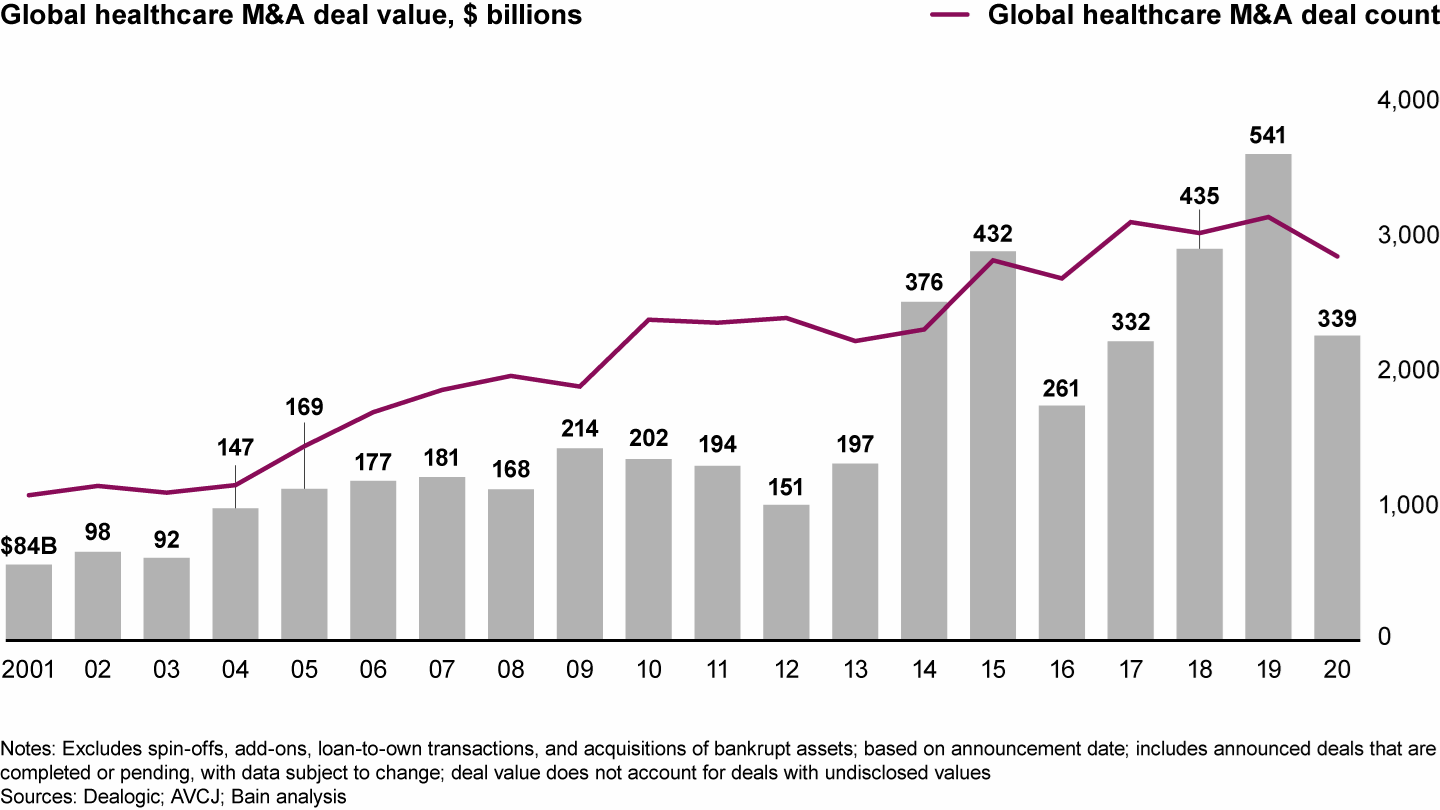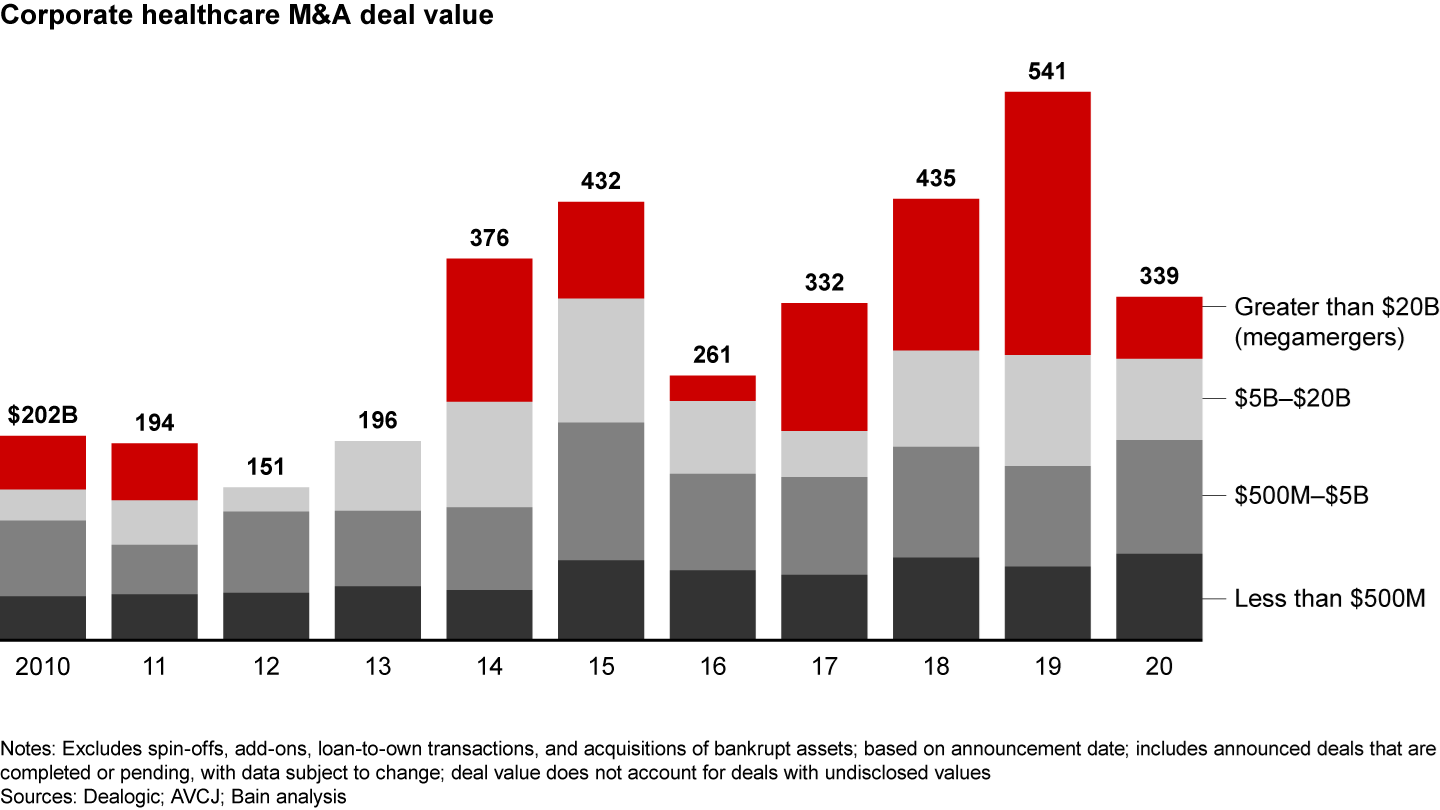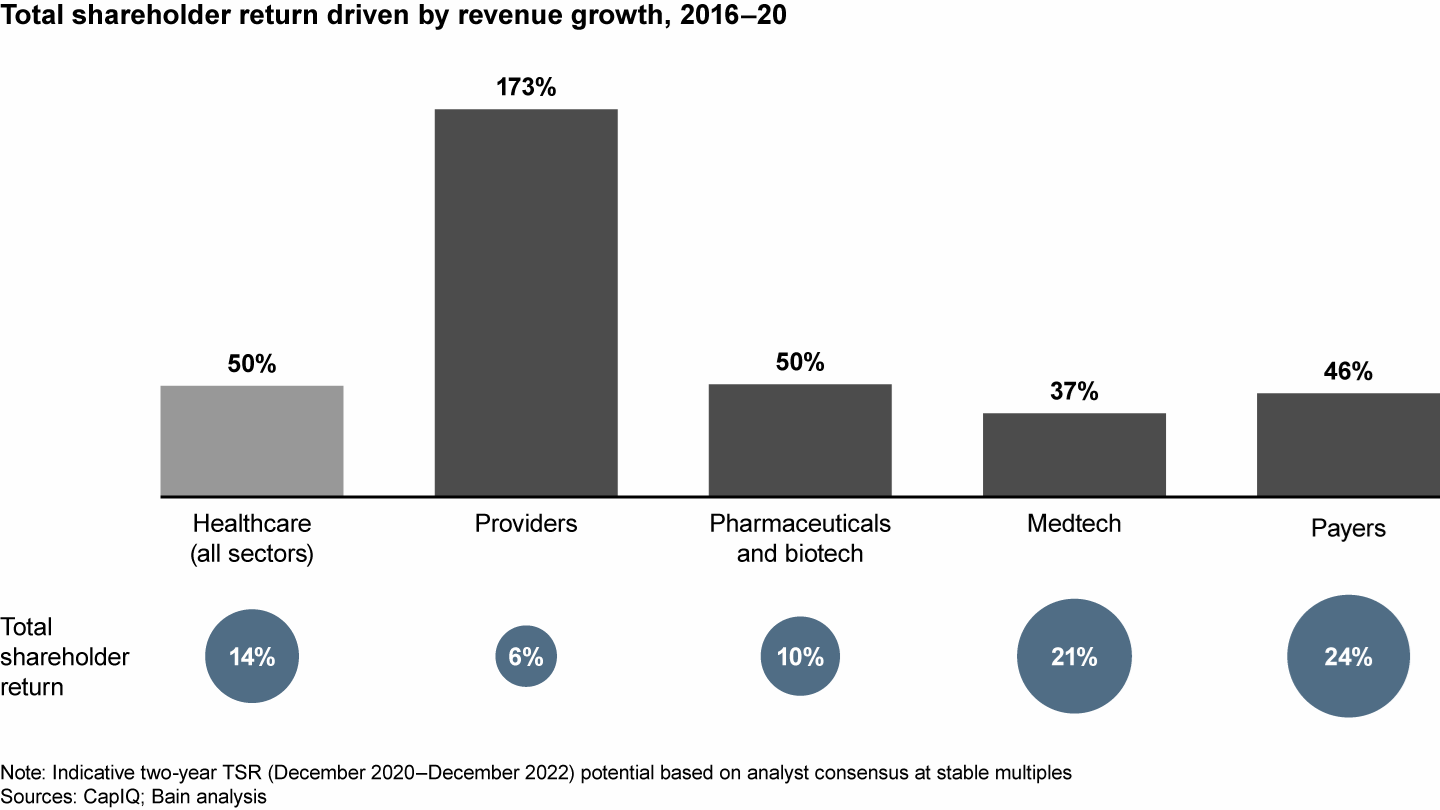Report

한눈에 보기
- After a banner 2019, overall healthcare disclosed deal values declined 37% to $338.6 billion. Deal volume also dropped by a more modest 9% to 2,845 deals.
- North America was the most active region, with 1,175 deals accounting for 80% of overall value. Biopharma was the most active sector, logging 998 deals for 67% of total value.
- Covid-19 caused many deals to be put on hold, as elective surgeries were restricted and other consequences rippled throughout healthcare.
- Looking ahead, we anticipate that M&A activity should rebound based on continued macro and healthcare sector-specific growth trends.
This article is part of Bain's 2021 Global Healthcare Private Equity and M&A Report.
After peaking in 2019, healthcare corporate M&A disclosed deal value dropped 37% to $338.6 billion. Deal volume also declined, albeit by a more modest 9%, to 2,845 deals (see Figure 1). While deals greater than $5 billion accounted for 42% of total value, the drop in the number of megamergers (over $20 billion) meant that value was less concentrated than in prior years (see Figure 2). Meanwhile, deals valued under $5 billion accounted for the remaining 58% of value, the greatest proportion since 2016. Deals of this size have traditionally been the most competitive with private equity sponsors, indicating that corporate entities mounted greater competition with sponsors than in 2019.
Healthcare corporate M&A disclosed value declined sharply


A dearth of megamergers accounts for the decline in disclosed deal value


Biopharma: Poised for sustained levels of activity as investors reward top-line growth
Biopharma deal volume declined 20% to 998 deals, and despite a value decline of 43% to $226.4 billion, biopharma still accounted for 67% of total healthcare M&A value. 2020’s two largest mergers, AstraZeneca-Alexion Pharmaceuticals ($40.1 billion) and Gilead-Immunomedics ($20.9 billion), were significantly smaller than the 2019 megamergers of BMS-Celgene ($74 billion) and Abbvie-Allergan ($63 billion). However, the persistence of very large mergers, albeit somewhat smaller, suggests that the sector’s fundamentals remain strong.
Meet the members of Bain’s Healthcare Private Equity practice.
Between 2016 and 2020, 50% of total shareholder return (TSR) in biopharma was driven by revenue growth, 2.5 times the effect of EBITDA (see Figure 3). The TSR for acquisitive and organic growth were quite similar. This suggests that the market rewards high gross margin biopharma firms most for revenue growth—a trend that, if it continues, will likely spur more transaction volume in the future.
Revenue growth accounts for half of total shareholder return in public healthcare companies


Pharma companies continued to use M&A to expand their R&D pipelines in therapeutic areas where they have expertise. For example, the $2.4 billion Biogen-Sangamo merger in gene regulation therapy will give Biogen access to promising treatments for neurological disorders. Overall, we expect corporates to continue being the biggest acquirers in biopharma, presenting strong competition to private equity sponsors.
Medtech: Restrictions on elective surgeries put a pause on many deals, though some segments are poised for strong activity
Covid-related restrictions on elective surgeries dampened medtech deal volume in 2020, which decreased 16% to 564, while deal value declined 60% to $39.2 billion. Moreover, one deal, Siemens’s acquisition of Varian, accounted for 42% of the total value in the sector.
The extent of limitations on access to hospitals for elective surgeries and commercial activities is uncertain in the near term, but we anticipate a revival of activity in two areas. First, diagnostic and testing companies received major cash infusions during the pandemic and could use it to reinvest in core areas or to seek adjacencies in other businesses. Second, companies with limited exposure to elective procedures, or those with a strong balance sheet, could opportunistically pick up distressed assets.
Once elective surgeries rebound and the uncertainty around commercial access to hospitals is resolved, the longer-term strategy of pursuing category leadership should return as a major motivator for more transactions.
Healthcare payers: An uptick in value, with investment likely to grow in areas accelerated by Covid-19
Breaking from the downward trend starting in 2017, payer deal volume and value both increased in 2020, with deal volume rising by 32% to 58 and deal value rising by 86% to $41.7 billion. While investors expected that corporates would still be digesting large acquisitions from previous years, they were actually more willing than anticipated to invest this year.
We expect activity to pick up in areas accelerated by Covid-19, such as enabling software for telehealth, and areas that have become increasingly relevant to providers for the future, such as payments technology. The $14.8 billion Teladoc Livongo merger was a clear example, in a deal that looks to better integrate telehealth into the care continuum for chronically ill patients.
PE sponsors are similarly focused on these areas, looking for opportunities to build platforms in payer technology, in order to create targets for future acquisitions.
Healthcare providers: Strong and getting stronger, with consolidation of physician practice management and alternative care sites
The pandemic considerably slowed the stream of provider deals in the first half of 2020 but picked up later in the year, leaving volume down by 18% to 547 deals but transaction value up 19% to $21.0 billion.
Many deals that did manage to close were characterized by consolidation of physician practice management and alternative care sites in order to reduce costs and improve patient outcomes through standardized processes. One such example was the North American Partners in Anesthesiology’s purchase of American Anesthesiology from MEDNAX.
In the coming year, significant opportunities exist for larger, well-run providers to acquire distressed assets. Additionally, telemedicine and virtual care capabilities might attract wider interest given the increased demand for this type of care following the pandemic.
Outlook: Divestitures should lag acquisitions
After a challenging 2020, the coming year may see distressed firms divesting assets to free up cash or to clean out portfolios. However, divestitures are expected to rebound at a slower pace than acquisitions, as companies focus on core business operations before turning to divestitures.
Past recessions have shown that firms willing to invest with a clear deal thesis in times of downturn can generate strong returns and gain market share gain. For instance, Medtronic has delivered an 11% annual TSR since the 2009 acquisitions of CoreValve and Ventor Technologies. We expect that category leadership will continue to motivate many acquisitions.
However, replicating past successes will entail developing a clear list of actions to achieve the most transaction value. Aggressive yet realistic synergies, one-time costs, the prospect of integrations in a virtual environment, and identifying people with the right talent will all be essential topics to address. Through strong planning and coordination, acquirers deliver on their deal and integration theses.
For more detail on the year’s M&A activity, read Bain’s Global M&A report.
More from the report
-
Welcome Letter: Fertile Conditions for Healthcare Private Equity Investment
-
Healthcare Private Equity Market 2020: The Year in Review
-
The Covid-19 Paradox: Widespread Repercussions for Demand, but New Healthcare Investment Opportunities as Well
-
Healthcare Private Equity in North America: Bring On the Gem Assets
-
Healthcare Private Equity in Europe: Steady Dealmaking despite Many Deferrals
-
Healthcare Private Equity in Asia-Pacific: Riding a Wave of Domestic Innovation
-
Healthcare Providers: New Roll-Up Candidates and a New Look for Risk-Bearing Providers
-
Healthcare Payers: A Bid to Reduce Costs for Patients and Employers
-
Biopharma: Commercialization Support Services Are Thriving
-
Medtech: Four Themes Fueled Deals despite the Pandemic
-
Healthcare IT: Technologies Help Improve Patient Experiences at Lower Costs
-
Healthcare M&A: A Pandemic-Induced Slowdown in Every Sector
-
Healthcare Exit Activity: Robust Capital Markets Spur a Surge of IPOs
-
Healthcare Private Equity Outlook: 2021 and Beyond